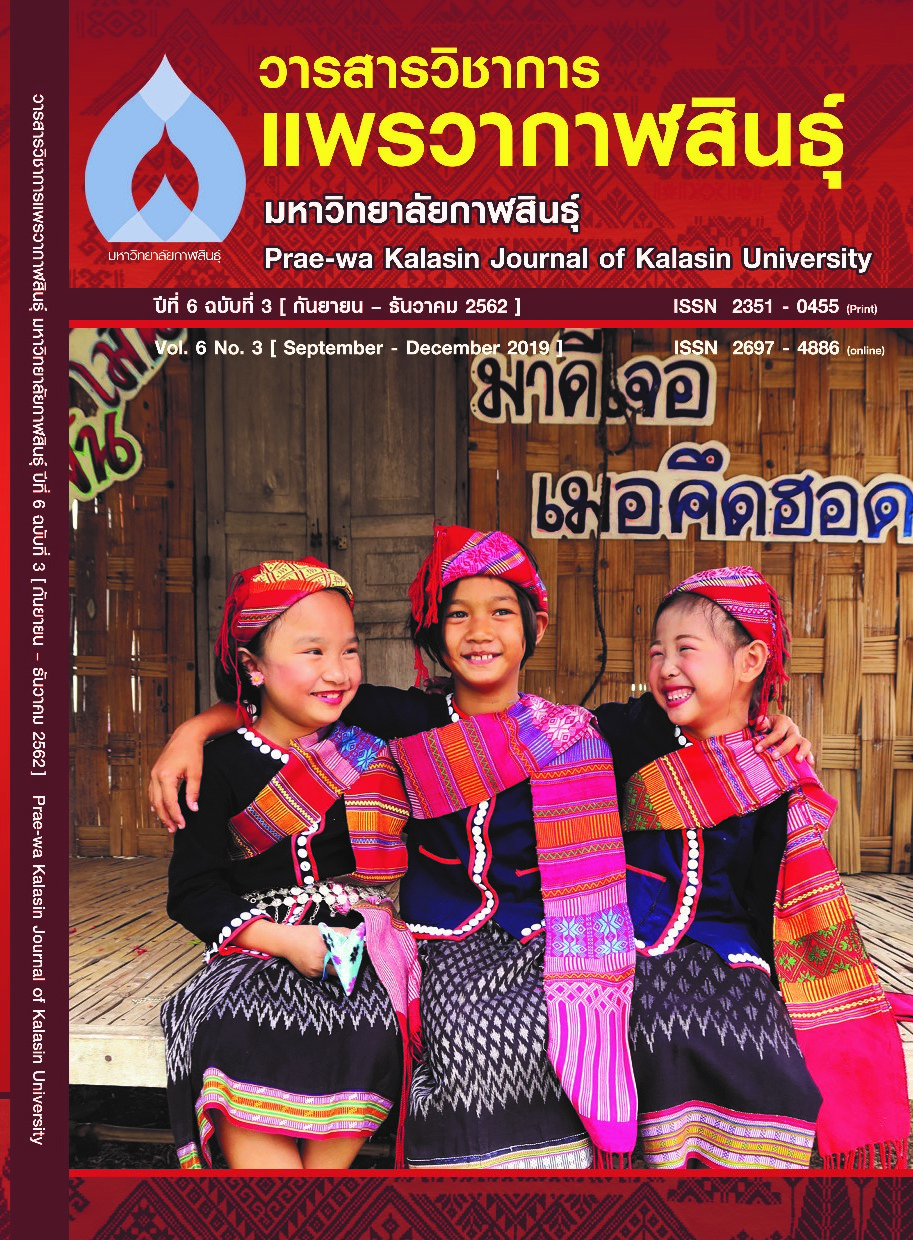การพัฒนารูปแบบการเรียนการสอนภาษาไทยเพื่อส่งเสริมทักษะการคิดขั้นสูง ของนักเรียนชั้นมัธยมศึกษาปีที่ 3
Main Article Content
บทคัดย่อ
การวิจัยครั้งนี้มีวัตถุประสงค์เพื่อ 1) พัฒนารูปแบบการจัดการเรียนรู้ภาษาไทยที่ส่งเสริมทักษะการคิดขั้นสูงสำหรับนักเรียนชั้นมัธยมศึกษาปีที่ 3 2) หาประสิทธิภาพของแผนการจัดการเรียนรู้ภาษาไทยที่ส่งเสริมทักษะการคิดขั้นสูงให้มีประสิทธิภาพ (E1/E2) ตามเกณฑ์ 80/80 3) เปรียบเทียบทักษะการคิดขั้นสูงก่อนเรียนและหลังเรียน และ 4) ศึกษาความพึงพอใจต่อการเรียน กลุ่มตัวอย่างเป็นนักเรียนชั้นมัธยมศึกษาปีที่ 3/11 ภาคเรียนที่ 2 ปีการศึกษา 2561 โรงเรียนบัวขาว จังหวัดกาฬสินธุ์ จำนวน 36 คน เครื่องมือที่ใช้ในการวิจัย ประกอบด้วย 1) รูปแบบการเรียนการสอนภาษาไทยเพื่อส่งเสริมทักษะการคิดขั้นสูงของนักเรียนชั้นมัธยมศึกษาปีที่ 3 2) แผนการจัดการเรียนรู้ 3) แบบทดสอบวัดทักษะการคิดขั้นสูง และ 4) แบบสอบถามความพึงพอใจต่อการเรียน สถิติที่ใช้วิเคราะห์ข้อมูลได้แก่ ร้อยละ ค่าเฉลี่ย ส่วนเบี่ยงเบนมาตรฐาน และทดสอบสมมติฐานใช้ t-test ผลการวิจัย พบว่า รูปแบบการเรียนการสอนภาษาไทยที่พัฒนาขึ้น “RECSEA Model” มีความเหมาะสมโดยรวมอยู่ในระดับมากที่สุด (4.76, S.D. 0.50) แผนการจัดการเรียนรู้มีประสิทธิภาพ (E1/E2) เท่ากับ 83.31/82.08 นักเรียนมีทักษะการคิดขั้นสูงก่องเรียนสูงกว่าหลังเรียนอย่างมีนัยสำคัญทางสถิติที่ระดับ .01 และนักเรียนมีความพึงพอใจโดยรวมอยู่ในระดับมาก (4.50, S.D. 0.55)
Article Details
References
Ministry of Education. (2008). Core Curriculum for Basic Education Act 2551. Bangkok: Printing Agriculture Cooperatives of Thailand.
จินตนา ศิริธัญญารัตน์. (2556). การพัฒนารูปแบบการเรียนการสอนวิทยาศาสตร์ที่บูรณาการกลยุทธ์การพัฒนาทักษะการคิดขั้นสูง เพื่อส่งเสริมทักษะการคิดขั้นสูงในศตวรรษที่ 21 และจิตวิทยาศาสตร์ของนักเรียนระดับมัธยมศึกษา. วิทยานิพนธ์ ปร.ด. นครปฐม : มหาวิทยาลัยศิลปากร.
Siri Thanyarat, Chintana (2013). The development of science teaching model that integrates development strategies Advanced thinking skills To promote advanced thinking skills in the 21st century and students' mental science Secondary level. Thesis, Nakhon Pathom Ph.D.: Silpakorn University.
จิระ ดีช่วย. (2554). การพัฒนารูปแบบการเรียนการสอนตามทฤษฎีคอนสตรัคติวิสซึมร่วมกับการคิดอย่างมีวิจารณญาณเพื่อเสริมสร้างมโนทัศน์ทางชีววิทยา และความสามารถในการสร้างองค์ความรู้ของนักเรียนชั้นมัธยมศึกษาปีที่ 4. วิทยานิพนธ์ ปร.ด. นครปฐม : มหาวิทยาลัยศิลปากร.
Deechuai, Chira (2011). Development of teaching and learning styles based on constructivist theory together with critical thinking to strengthen biological concepts. And the
ability to create knowledge of mathayom suksa four students. Doctor of Philosophy degree Department of Curriculum and Teaching Method Silpakorn University.
ชมนาด เชื้อสุวรรณทวี. (2555). การพัฒนารูปแบบการเรียนการสอนคณิตศาสตร์เพื่อส่งเสริมความสามารถในการคิดขั้นสูงและจิตตนิสัยของนักเรียนระดับมัธยมศึกษา.วิทยานิพนธ์ ปร.ด. นครปฐม : มหาวิทยาลัยศิลปากร, 2555.
Chaisuwanawee, Chomnad. (2012). Development of a model for teaching mathematics to promote ability In Advanced Thinking and Contemplation of Secondary School
Students. Nakhon Pathom Ph.D. Thesis: Silpakorn University, 2012.
ฐิติรัตน์ ปัญญาเยาว์. (2559). ผลการสอนแบบสืบเสาะหาความรู้ร่วมกับการใช้ผังมโนรูปตัววี เพื่อส่งเสริมการคิดวิคราะห์ของนักเรียนชั้นมัธยมศึกษาปีที่ 2. วิทยานิพนธ์ ศษ.ม. เชียงใหม่ : มหาวิทยาลัยเชียงใหม่.
Panyayao, Thitirat. (2016). The result of inquiry-based learning with the use of V-shaped mapping To promote thinkingAnalysis of Mathayom Suksa 2 Students. Thesis, Chiang Mai : ChiangMai University.
ดุจเดือน ไชยพิชิต. (2558). การพัฒนารูปแบบการจัดการเรียนรู้โดยผสานทฤษฎีคอนสตรัคติวิสต์กับกลวิธีการให้เหตุผลเพื่อส่งเสริมการคิดอย่างมีวิจารณญาณ ของนักเรียนชั้นมัธยมศึกษาตอนต้น. วิทยานิพนธ์ ปร.ด. มหาสารคาม : มหาวิทยาลัยมหาสารคาม.
Chaipichit, Dutdeun. (2015). Development of learning management model by integrating constructivist theory with strategies Give reasons to promote critical thinking Of lower secondary school students. thesis Mahasarakham : Mahasarakham University.
ทิศนา แขมมณี. (2553). ศาสตร์การสอนองค์ความรู้เพื่อการจัดกระบวนการเรียนรู้ที่มีประสิทธิภาพ. พิมพ์ครั้งที่ 12. กรุงเทพฯ: สำนักพิมพ์แห่งจุฬาลงกรณ์มหาวิทยาลัย.
Khaemmanee, Tisana. (2010). The science of teaching knowledge for effective learning process management. (12th ed). Bangkok: Chulalongkorn University Publishing House.
บุญชม ศรีสะอาด. (2553). วิจัยสำหรับครู. กรุงเทพฯ: สุวีริยาสาส์น.
Sri-Sa-Ard, Boonchom. (2010). Research for teacher. Bangkok: Suriyasan.
ประสาท เนืองเฉลิม. (2556). วิจัยการเรียนการสอน. พิมพ์ครั้งที่ 2. กรุงเทพฯ: สำนักพิมพ์แห่งจุฬาลงกรณ์มหาวิทยาลัย.
Nueang Chalerm, Prasarn. (2013). Teaching and learning research. (2th ed). Bangkok: Chulalongkorn University Publishing House.
ประสาท เนืองเฉลิม. (2557). การเรียนรู้วิทยาศาสตร์ในศตวรรษที่ 21. มหาสารคาม: อภิชาติการพิมพ์.
Nueang Chalerm, Prasarn. (2013). Science learning in the 21th century. Mahasarakham: Aphichat Phim.
มาเรียม นิลพันธุ์. (2558). วิธีวิจัยทางการศึกษา. พิมพ์ครั้งที่ 9. นครปฐม: ศูนย์วิจัยและพัฒนาทางการศึกษา คณะศึกษาศาสตร์ มหาวิทยาลัยศิลปากร.
Nilphan, Mariam. (2015). Educational research methods. (9th ed).Nakhon Pathom: Educational Research and Development Center Faculty of Education Silpakorn University.
สุมาลี ชัยเจริญ. (2557). การออกแบบการสอน หลักการ ทฤษฎี สู่การปฏิบัติ=Instructional Design: Principles and Theories to Practice. ขอนแก่น: สาขาเทคโนโลยีการศึกษา คณะศึกษาศาสตร์ มหาวิทยาลัยขอนแก่น.
Chaicharoen, Sumalee. (2014). Design of teaching theories to practice = Instructional Design: Principles and Theories to Practice. Khon Kaen: Educational Technology Faculty of Education Khonkaen University.
สำนักงานคณะกรรมการการศึกษาแห่งชาติ. (2545). แผนพัฒนาการศึกษาแห่งชาติ (พ.ศ. 2545-2559). กรุงเทพฯ: [ม.ป.พ.].
Office of the National Education Commission. (2002). National Education Development Plan (2002-2016). Bangkok: [Ph.D.].
สำนักงานคณะกรรมการการศึกษาแห่งชาติ. (2553). พระราชบัญญัติการศึกษาแห่งชาติ พ.ศ. 2542 และที่แก้ไขเพิ่มเติม (ฉบับที่ 3) พ.ศ. 2553. กรุงเทพฯ: องค์การรับส่งสินค้าและพัสดุภัณฑ์ (ร.ส.พ.).
Office of the National Education Commission. (2010). National Education Act, 1999 and amended (No. 3) 2010. Bangkok: Shipping and Logistics Organization.
อรัญญา สถิตไพบูลย์. (2553). การพัฒนาทักษะการคิดอย่างมีวิจารณญาณและผลสัมฤทธิ์ทางการเรียน วิชาเคมีของนักเรียนชั้นมัธยมศึกษาปีที่ 5 โดยใช้กระบวนการเรียนรู้แบบสืบเสาะหาความรู้.วิทยานิพนธ์ ศษ.ม. ขอนแก่น : มหาวิทยาลัยขอนแก่น.
Sathitphaiboon, Aranya. (2010). Development critical thinking skills and learning achievement. Chemistry of Mathayom Suksa 5 students using the inquiry-based learning process. Master of Education Thesis Science Education College Khonkaen University.
อารยา ช่ออังชัญ. (2553). การพัฒนารูปแบบการเรียนการสอนเพื่อส่งเสริมความสามารถในการคิดแก้ปัญหาอย่างมีวิจารณญาณของนักเรียนชั้นประถมศึกษาปีที่ 5. วิทยานิพนธ์ ปร.ด. นครปฐม : มหาวิทยาลัยศิลปากร.
Choangchan, Araya. (2010). The Development of instructional Model for the Enhancement of Problem Solving with Critical Thinking Abilities in Science of Fifth Grade Student. Doctor of Philosophy Silpakorn University.
อัมพวัลย์ โชติจำลอง. (2555). การพัฒนาความสามารถด้านการอ่านคิดวิเคราะห์ของนักเรียนชั้นมัธยมศึกษาปีที่ 2 ด้วยหน่วยการเรียนรู้แบบบูรณาการสาระการเรียนรู้ภาษาไทย. วิทยานิพนธ์ ศษ.ม. ขอนแก่น : มหาวิทยาลัยขอนแก่น.
Chotjumlong, Amphawan. (2012). Development of reading and analytical ability of mathayom suksa two students with integrated learning units for Thai language learning. Master of Education Thesis In Curriculum and Instruction College Khonkaen University.
Anthony W.L. (2001). The Learning Cycle as a Tool for Planning Science Instruction [Online]. Accessed June 2001. Available from http://coe.ilstu.edu/scienceed/lorbach/257/rcy.htm
Carin, A. (1993). Teaching science through discovery. 7th ed. New York: Merrill.
Devrics, R. and Zan, B. (1992). “Study compares teachers and classroom atmospheres.” The Constructivist, 6(Spring), 925-927.
Driver, R. and Bell, B. (1986). “Students thinking and the learning of science : A Constructivist View.” The School Science Review, 67(240), 443-456.
Eisenkraft, A. (2003). “Expanding the 5E Model.” The Science Teacher, 5(6), 57-59; September.
Kevin, K. (2008). Instruction to Instruction Design and ADDIE Model [Online]. Accessed 19 June. Available from http://www.e-learningguru.com/articles/art_1.htm
McDonald, C.V. (2010). The Influence of Explicit Nature of Science and Argumentation Instruction on Preservice Primary Teachers’ Views of Nature of Science. Journal of Research in Sciences Teaching, 47(9), 1137-1164.
Morrison, G.R. (2010). Designing Effective Instruction. 6th ed. New Jersey: John Wiley & Sons.
Nuangchalerm, P. (2010). Engaging Students to perceive Nature of Science through Socioscientific Issues-based Instruction. European Journal of Social Sciences, 13(1), 34-37.
Olenick and David Walbert. (2008). The Learning Cycle [Online]. Accessed August. Available from http://www.Learnnc.org/lp/pages/663?Style
